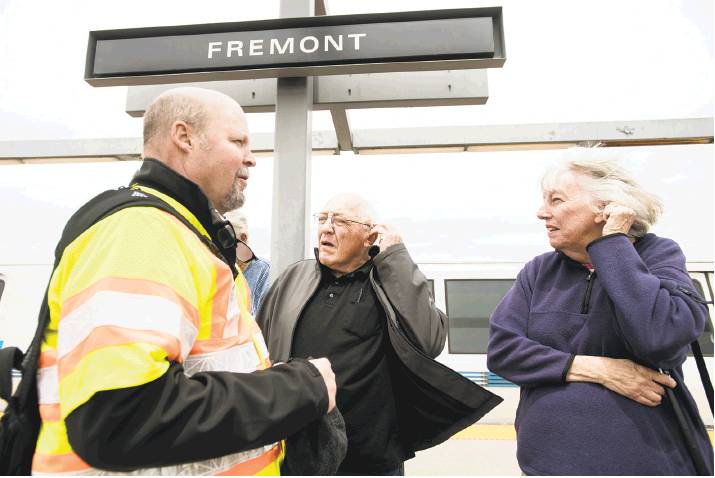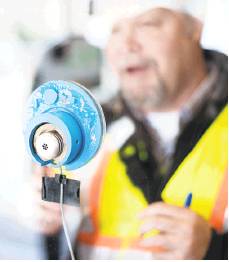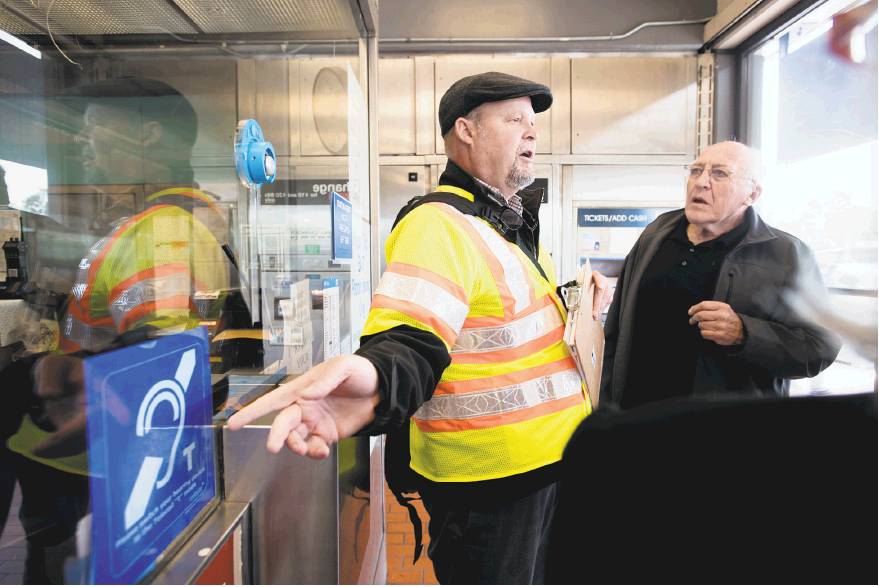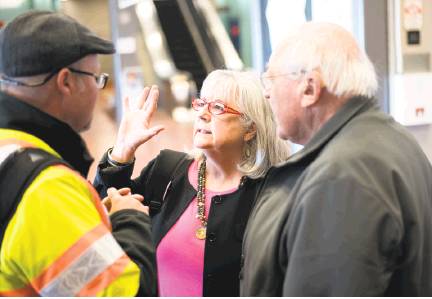BART trying to loop in hearing-impaired riders
By Benny Evangelista
Jill McFadden’s eyes widened in amazement as words that most BART riders take for granted beamed directly into her ears.
“10-car San Francisco train approaching, platform 2,” a grinning McFadden repeated, shooting her right thumb upward. “OK, I love it.”
The Pleasant Hill resident was trying out a new BART hearing service, which converts the audio into electromagnetic signals that can be picked up with compatible hearing aids or cochlear implants. According to the American Public Transportation Association, BART appears to be the first public transit agency in the U.S. to install the technology, called a hearing-loop system, with the test in its Fremont Station.
It cost about $300,000 to outfit the Fremont Station, and there’s no funding to expand. It was also clear from a group of five people with varying degrees of hearing loss who visited Fremont last week that the system still needs major adjustments. One, Ann Thomas of Alamo, said what she heard still sounded like “chicken scratch.”
However, BART plans to test the technology on its replacement fleet of cars. And for riders like Moraga’s Anita Ogden, any step that helps her hear important public-address announcements is a positive.
“Oh, my goodness. ‘Do not board’ — I heard that! ” Ogden said of an announcement that was almost inaudible to riders who didn’t have a hearing aid. “The train at platform something is out of service. I never would have heard that, although there’s a perfectly clear sign that says ‘not in service.’ ”
About 17 percent of U.S. adults have some degree of hearing loss, and for people 75 or older, the figure climbs to 50 percent, according to the National Institutes of Health. However, only about 20 percent of people with hearing loss use hearing aids.
“The level of your hearing loss affects how well you function in society and a variety of situations,” Thomas said.
Hearing-loop technology is available for people who wear hearing aids equipped with an internal antenna called a telecoil, or T-coil. Spoken words picked up by a microphone or fed into a public-address system are linked to the loop, a thin wire that converts the audio into a magnetic signal that’s then picked up by the T-coil, which has to be switched on by the wearer.
The hearing aid processes the audio and feeds it into the wearer’s ears. The hearing aid can reduce the background noise or other acoustic problems, said Juliëtte Sterkens, a retired Wisconsin audiologist who is a now a full-time national hearing-loop advocate for the Hearing Loss Association of America.
Hearing aids work best about 6 feet or less from the person talking, according to Sterkens. When a large area like a church, museum or library is “looped,” the distance is greatly increased.
“They can hear the sound as if they are mere inches from the mouth of the speaker,” she said.
New York City approved legislation this year that requires loops in new or renovated public assembly areas. But California “is late to the game,” said Thomas, who is president of the Hearing Loss Association’s Diablo Valley Chapter.
Although dozens of Bay Area churches have been looped, “none of the major performing arts centers currently have them,” Thomas said in an email.
The Landmark Theatre movie chain began looping screens in 2013 whenever it does a renovation or new construction, said CEO Ted Mundorff. In the Bay Area, Landmark has looped 22 screens in four theaters, but Mundorff said he “had no idea” whether the technology has brought in more customers, and he said it didn’t matter to him.
“It’s more important to put them in when we can, because it’s a great device,” he said.
The BART project has taken several years to come to fruition and was originally proposed for the new Warm Springs Station, said Janice Armigo Brown, a member of BART’s accessibility task force.
“It took time to learn and be educated about what the technology entailed and how it actually works,” she said in an email. “From there, it took time for BART to engineer the technology. As you know, BART stations have a mix of concrete, steel, underground wiring, multiple station levels. Very complex.”
BART officials said transit agencies in Europe and Australia use hearing loops. The only other known transit stop in North America with a test hearing-loop system is in downtown Toronto, said Virginia Miller, the American Public Transportation Association’s media-relations director.
At the Fremont Station, BART crews embedded a thin wire around the perimeter of the platform, along the edge of the yellow boarding strip, and in an expansion seam along the middle. That system picks up normal public-address announcements broadcast on speakers, but can be heard even by people wearing T-coil-enabled hearing aids at the ends of the platform, where even riders with normal hearing can’t hear them.
Smaller loops are installed in the station agent’s booth. On Tuesday, when BART invited members of the Diablo Valley Chapter to evaluate the system, the group listened as BART project manager Carl Orman spoke. BART trains constantly rumbled overhead, making Orman’s comments hard for anyone to hear.
“There’s nothing quiet about this station,” said George Hastings of Livermore.
Members of the group gave the system mixed marks, saying they still heard audio feedback and the static emitted by BART’s electric-propulsion system.
“The loop is wonderful,” McFadden said. “The downside is I can also hear the electromagnetic buzzing.”
Thomas said BART needs more improvements to make the system usable for all riders with hearing loss.
“For me, it’s not functional,” she said. “It’s not that I can’t hear sound. I don’t have clarity.”
Orman said BART is still working to refine the system, which will remain in an “open-ended” pilot phase. Whether BART installs loops in other stations depends on how it ultimately ranks against other accessibility projects.
Ogden said she was pleased that when she stood on the platform, she could hear elevator updates and train arrivals sent “right into my ear. My church has moved the sermon right into my ear. Makes a lot of difference. The real test, and the real concern I have, is in an emergency.”
She thought about how other BART riders sifted through the normal station noise.
“I don’t think it’s clear for people with normal hearing,” she said.
Benny Evangelista is a San Francisco Chronicle staff writer. Email: bevangelista@sfchronicle.com Twitter: @ChronicleBenny
“The loop is wonderful. The downside is I can also hear the electromagnetic buzzing.”
Jill McFadden, testing the loop system
Coming next Sunday: A special section on the Future of Health



